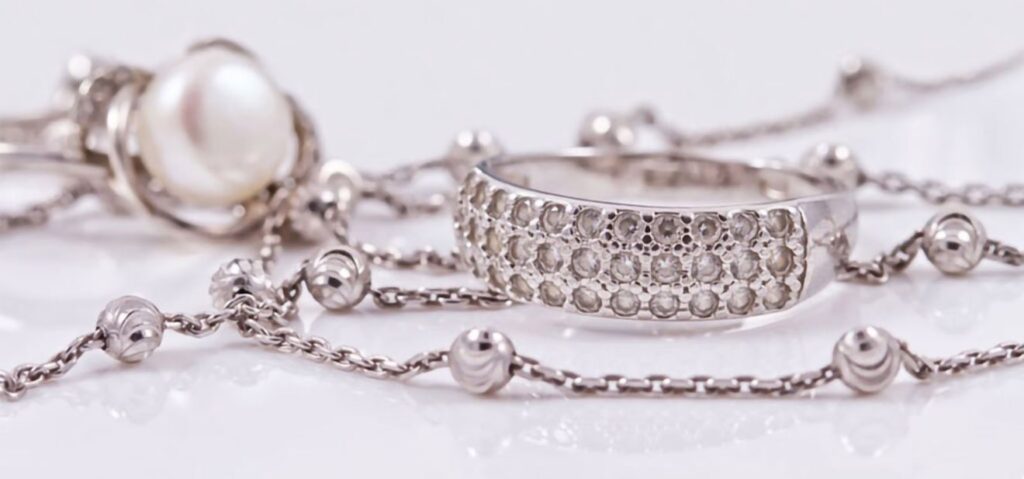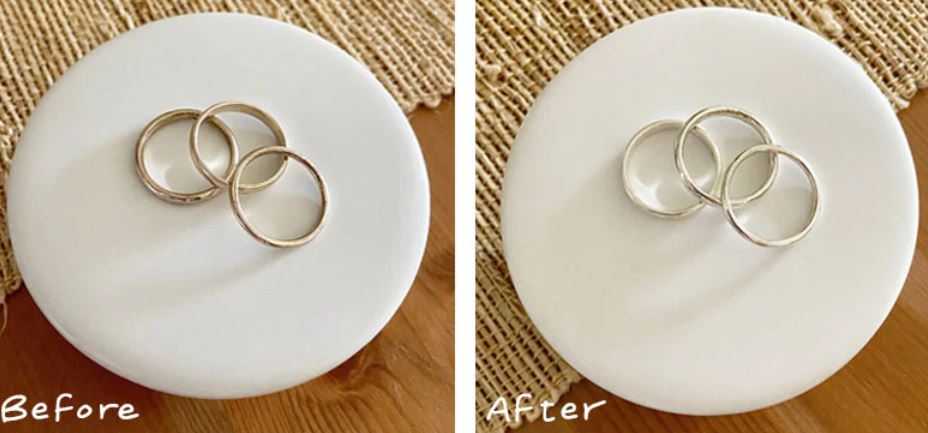Does Gold Plated Sterling Silver Tarnish
Gold sterling silver can only tarnish if gold plated layer is eroded away. If this layer is remained intact, gold sterling silver will not tarnish. If this layer wears off, then it will take around 3 to 4 months to tarnish sterling silver. In order to avoid this tarnishing, you will have to re-plate your gold plated jewelry every time gold plating wears off.
In this article, we’ll answer can sterling silver be gold plated, does gold over sterling silver tarnish, what factors are the most important and how can you save it from tarnishing.
Composition of Gold Plated Sterling Silver
Sterling silver or 925 silver can be gold plated and its a popular choice of metal among buyers. Gold plated sterling silver is gold plated over base metal of sterling silver. This gold layer is about less than 0.5 microns thick and easily fade away with even minor damages. Normally, it can take anywhere from 2 to 4 months of regular usage to fade it. Any minor or major damages will fasten this process. These damages include water damage, scratching, falling on the floor etc.
This fading of outer gold plating will expose the sterling silver metal to atmosphere. And sterling silver will react with atmospheric chemicals to form tarnish.
Why Does Gold Plated Sterling Silver Tarnish?
Gold itself does not tarnish. However, the underlying sterling silver can tarnish if the gold layer wears away. Sterling silver is a combination of silver and copper. Copper is one metal that can develop tarnishing with time once it comes in contact with atmospheric chemicals like sulfur.
Once your gold plated sterling silver loses its gold plating, it will start tarnishing.
Tarnishing is a natural process which cannot be avoided. However, there are methods which can be used to prolong this process.

Does Gold Plated Tarnish
Any gold plated jewelry is going to tarnish which contains either of these metals as base.
- Sterling silver
- Copper
- Brass
- Bronze
If it is any other metal, it will not tarnish.
Does 14k Gold Plated Sterling Silver Tarnish
Yes, it does tarnish. Tarnishing will start once plating wears off. It will not tarnish until gold plating remains intact.
Does 18k Gold Plated Sterling Silver Tarnish
Yes, just like 14k gold plated, it also tarnishes once gold plating wears off. This way, we can say gold over sterling silver tarnishes.
Does 18k Gold Plated Sterling Silver Turn Green
No, 18k gold plated sterling silver does not turn green. It turns black on tarnishing. Only copper and its metals turn green on tarnishing.
Why Use Gold Plated Sterling Silver
Gold is an expensive metal. Not everyone can afford it. Specifically if you want to buy a heavy piece of jewelry like a Cuban chain. So, if you want to get gold alike looks in a low budget, then gold plated sterling silver can be a good option. It is not very expensive and can save you a lot of money. Buyers can get aesthetic looks of gold while paying way less.
How Much Time Will It Take To Tarnish?
Gold or gold plating does not tarnish itself. But sterling silver does. As long as gold plating is there, sterling silver will not tarnish. However, gold plating cannot last more than 3 to 4 months on regular use. Once it wears off, sterling silver will take another 3 to 4 months to tarnish. So, you can say that if your gold plated sterling silver jewelry is new, it will take 7 to 8 months to tarnish. And if gold plating has gone away, it will take 3 to 4 months to tarnish.
How to Save Gold Plated Sterling Silver from Tarnishing
There are not many things you can do in case of gold plated sterling silver. All you have to do is to not allow the gold plating to wear off.

1. Buy Gold Plating of lower Purity
No gold plating is permanent. It is going to wear off after some time of usage. All you can do is to delay this process by protecting it from fading. Gold plating of lower purity karats like 14 karats can stay for longer period than higher purity gold plating like 18 karats.
Apart, thickness also plays a role in appearance as well as protecting jewelry from tarnishing.
2. Re-plate every 3 months
Gold plating is going to wear off eventually no matter how better you take care of your jewelry. All of these methods are just to minimize this effect. Constant rubbing and abrasion can wear away the gold layer, exposing the underlying silver. Apart, exposure to cosmetic items like perfumes and lotions can also damage the gold layer.
So, if you are a regular wearer of gold plated jewelry, its better to re-plate it regularly.
3. Visit Your Jeweler Regularly
If you have a big collection of jewelry, it is better to visit your jeweler regularly. Jewelers do identify any problems that are happening or going to happen with each and every item of your collection. It will not only keep your jewelry just like original but also identify any potential issues which might become big in future.
4. Avoid using Harsh Chemicals
To maintain the appearance of gold-plated sterling silver, it’s important to avoid harsh chemicals, abrasive materials, and excessive wear that could expose the silver underneath. These chemicals are bleach, detergents and any chemicals used in laundry.
5. Don’t Clean Gold plated Jewelry Too much
Cleaning your gold plated sterling silver jewelry too much can also be a problem. Cleaning involves rubbing, scuffing etc. which can remove the gold layer.
If you have to wash your jewelry, use a mild soap and warm water solution to clean the jewelry. And gently scrub the surface using a soft cloth like velvet. Try not to be forceful or gold plating can wear off.
6. Proper Storage
Store your jewelry in a dry, airtight container that can not allow air to enter. You can also use anti-tarnishing strips. Make sure jewelry box has separate compartment for each jewelry item. It will prevent rubbing against each other.

What Things can Tarnish Gold Plated Sterling Silver
Many factors contribute to tarnishing of a metal including sweating, cosmetic chemicals and many more. Some of the important contributing factors are:
1. Quality of Gold Plating
Thicker gold layers provide better protection against tarnishing. If this layer is remained intact on sterling silver, it will protect it from tarnishing. The moment it starts to wear off, sterling silver can start tarnishing. It will take about 3 to 4 months to tarnish sterling silver.
2. Exposure to Elements
Sulfur is the main reason of tarnishing due to atmospheric chemicals. It can speed up tarnishing very quickly. Apart, water can also tarnish jewelry. Its better to avoid doing tasks that involve water when you are wearing jewelry. It can include swimming, showering, laundering and washing hands.
3. Sweat and Cosmetic Items
Sweat and cosmetic items like perfume and lotions can increase the speed of tarnishing. It is often recommended to avoid wearing gold plated jewelry on a hot day where you can get a lot of sweat. Its better to just avoid spraying perfume or applying lotion directly on jewelry.
4. Friction
Friction can be another reason for tarnishing. Though, it might not directly contribute to tarnishing but it will result in fading of jewelry. And once it is faded, it will expose sterling silver to atmosphere for tarnishing.
Is Gold plated Sterling Silver good
Sterling silver with gold plating can be a good choice if you are looking to get gold alike looks at a much lower cost. Gold plating can provide an affordable way to step up your aesthetic looks and fashion.
However, every buyer should be aware of the potential cons of gold plated sterling silver as well. Gold plating can go away quickly and it can tarnish. A buyer will have to take care of it with extreme measures.
But if you can afford solid gold, then gold plated jewelry is a straight away No.
Common FAQ’s about Gold over Sterling Silver Jewelry
Here are some common FAQ’s.
Does 925 Gold Tarnish?
Yes, 925 gold tarnishes. It is just another name for sterling silver gold plated.
Is Gold Plated Sterling Silver Good?
Gold plated sterling silver is a good option for those who want a cheap alternative but low quality alternative of solid gold jewelry. If you have the budget of buying solid gold, then definitely go for it.
How much will re-plating cost?
It depends on the size of the jewelry item. Normally it costs around $25 to $35.
Does Gold Plated Sterling Silver has any Resale Value?
Any gold plated jewelry never has any resale value on its own. However, you can get some resale value out of the base metal which is in this case is sterling silver. But it will not be much.
Can Gold Plated Sterling Silver come in different Plating Thickness?
Yes, it does come. Normally, whenever you buy a gold plated jewelry, it is written in product description. Its better to buy one with more thickness.
Conclusion
Gold plated sterling silver can be a good piece of jewelry. All depends on what you expect from your jewelry. If you are one who wants to get gold look alike jewelry for a minimum price, then gold plated sterling silver is for you. But you should note that gold plating will not last for a long time. If you have the budget of solid gold, then definitely buy it rather than gold plated sterling silver.